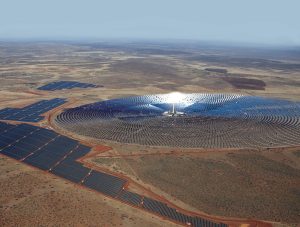Integrated Solar Thermal Hybrid Power Plants: CSP and PV
Integrated Solar Thermal Hybrid Power Plants are emerging as a promising solution to address the growing global demand for clean and sustainable energy. These innovative power plants combine the strengths of both solar thermal and photovoltaic (PV) technologies, harnessing the sun’s energy to generate electricity in a more efficient and cost-effective manner. As the world grapples with the urgent need to transition away from fossil fuels and mitigate the impacts of climate change, integrated solar thermal hybrid power plants offer a glimpse into the future of renewable energy generation.
One of the key advantages of integrated solar thermal hybrid power plants is their ability to generate electricity even when the sun is not shining. Solar thermal technology captures and stores the sun’s heat, which can then be used to produce steam and drive a turbine to generate electricity. This stored thermal energy can be tapped into during periods of low sunlight or at night, ensuring a continuous supply of electricity. On the other hand, photovoltaic technology directly converts sunlight into electricity using solar cells. By combining these two technologies, integrated solar thermal hybrid power plants can generate electricity throughout the day, addressing one of the main limitations of standalone solar power systems.
Another benefit of integrated solar thermal hybrid power plants is their potential for increased efficiency. Solar thermal technology can achieve higher temperatures than photovoltaic systems, which allows for more efficient electricity generation. Moreover, the integration of solar thermal and photovoltaic technologies can lead to a reduction in the overall cost of electricity production. This is because the two technologies can share infrastructure, such as land, grid connections, and support structures, leading to cost savings. Additionally, the hybrid nature of these power plants allows for the optimization of energy production, as the system can switch between solar thermal and photovoltaic generation depending on the available sunlight and temperature conditions.
As the demand for clean energy continues to grow, integrated solar thermal hybrid power plants are attracting increasing interest from governments, investors, and energy companies worldwide. Several pilot projects and commercial-scale installations have already been successfully implemented, demonstrating the feasibility and potential of this innovative technology. For instance, the world’s first integrated solar thermal hybrid power plant was commissioned in India in 2013, combining a 50 MW solar thermal plant with a 50 MW photovoltaic plant. This groundbreaking project has paved the way for further research and development in the field, as well as the deployment of integrated solar thermal hybrid power plants in other countries.
One of the main challenges facing the widespread adoption of integrated solar thermal hybrid power plants is the need for further technological advancements and cost reductions. While solar thermal and photovoltaic technologies have both experienced significant improvements in efficiency and cost over the past few decades, there is still room for further progress. Continued research and development efforts are crucial to ensure that integrated solar thermal hybrid power plants can compete with other forms of renewable energy, as well as traditional fossil fuel-based power plants.
In conclusion, integrated solar thermal hybrid power plants represent a promising and innovative solution to the world’s growing energy needs. By combining the strengths of solar thermal and photovoltaic technologies, these power plants can generate electricity more efficiently and cost-effectively than standalone solar systems. As the global community continues to search for ways to transition to a more sustainable and low-carbon energy future, integrated solar thermal hybrid power plants offer a glimpse into the potential of renewable energy generation. With continued research, development, and investment, these power plants could play a significant role in shaping the future of clean energy.
Terence West

